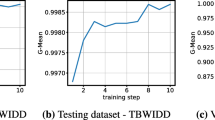Abstract
The digitalization of society potentialized services provided through the Internet, such as information sharing, entertainment, and education. With the rise of end-user services, we also verify the growth of attacks. Unfortunately, most defensive techniques of Web Intrusion Systems cannot deal with the complexity of cyber attacks on HTTP requests. Nevertheless, machine learning approaches are now a promising tool in different areas that can help to detect known and unknown attacks on day zero. We propose a new approach to detect possible attacks on HTTP requests based on machine learning. The new model LogBERT-BiLSTM uses BERT and Bidirectional LSTMs to detect anomalies in data. Experiments compared the proposed approach with literature models on CSIC 2010 and ECML/PKDD 2007 datasets. In addition, we created a new dataset of HTTP requests to evaluate the model performance. The proposed model obtained detection rates consistently above 95% of accuracy on the evaluated datasets.
Access this chapter
Tax calculation will be finalised at checkout
Purchases are for personal use only
Similar content being viewed by others
Notes
- 1.
Regex is the abbreviation of the English Regular Expressions, for regular expressions.
References
Assigning attack signatures to security policies, February 2022. https://techdocs.f5.com/kb/en-us/products/big-ip_asm/manuals/product/asm-bot-and-attack-signatures-13-0-0/1.html
Althubiti, S., Yuan, X., Esterline, A.: Analyzing http requests for web intrusion detection, October 2017
Chen, Z., Liu, J., Gu, W., Su, Y., Lyu, M.R.: Experience report: deep learning-based system log analysis for anomaly detection. CoRR abs/2107.05908 (2021). https://arxiv.org/abs/2107.05908
Du, M., Li, F., Zheng, G., Srikumar, V.: DeepLog: anomaly detection and diagnosis from system logs through deep learning, pp. 1285–1298 (2017). https://doi.org/10.1145/3133956.3134015
Guo, H., Yuan, S., Wu, X.: LogBERT: log anomaly detection via BERT. In: 2021 International Joint Conference on Neural Networks (IJCNN), pp. 1–8 (2021). https://doi.org/10.1109/IJCNN52387.2021.9534113
Ito, M., Iyatomi, H.: Web application firewall using character-level convolutional neural network, pp. 103–106 (2018). https://doi.org/10.1109/CSPA.2018.8368694
Kim, Y.: Convolutional neural networks for sentence classification. CoRR abs/1408.5882 (2014). http://arxiv.org/abs/1408.5882
Kuang, X., et al.: DeepWAF: detecting web attacks based on CNN and LSTM models (2019). https://doi.org/10.1007/978-3-030-37352-8_11
Le, V., Zhang, H.: Log-based anomaly detection without log parsing. CoRR abs/2108.01955 (2021). https://arxiv.org/abs/2108.01955
Lu, S., Wei, X., Li, Y., Wang, L.: Detecting anomaly in big data system logs using convolutional neural network (2018). https://doi.org/10.1109/DASC/PiCom/DataCom/CyberSciTec.2018.00037
Meng, W., et al.: LogAnomaly: unsupervised detection of sequential and quantitative anomalies in unstructured logs. In: IJCAI (2019)
Odumuyiwa, V., Chibueze, A.: Automatic detection of http injection attacks using convolutional neural network and deep neural network. J. Cyber Secur. Mobil. 9, 489–514 (2020)
Oliner, A., Stearley, J.: What supercomputers say: a study of five system logs (2007). https://doi.org/10.1109/DSN.2007.103
Raïssi, C., Brissaud, J., Dray, G., Poncelet, P., Roche, M., Teisseire, M.: Web analyzing traffic challenge: description and results (2007)
Torrano-Gimenez, C., Perez-Villegas, A., Alvarez, G.: A self-learning anomaly-based web application firewall, vol. 63, pp. 85–92, January 2009. https://doi.org/10.1007/978-3-642-04091-7_11
Vaswani, A., et al.: Attention is all you need. CoRR abs/1706.03762 (2017). http://arxiv.org/abs/1706.03762
Xuan, C., Dinh, H., Victor, T.: Malicious url detection based on machine learning. Int. J. Adv. Comput. Sci. Appl. (2020). https://doi.org/10.14569/IJACSA.2020.0110119
Yu, L., et al.: Detecting malicious web requests using an enhanced textCNN (2020). https://doi.org/10.1109/COMPSAC48688.2020.0-167
Author information
Authors and Affiliations
Corresponding author
Editor information
Editors and Affiliations
Rights and permissions
Copyright information
© 2022 The Author(s), under exclusive license to Springer Nature Switzerland AG
About this paper
Cite this paper
Ramos Júnior, L.S., Macêdo, D., Oliveira, A.L.I., Zanchettin, C. (2022). LogBERT-BiLSTM: Detecting Malicious Web Requests. In: Pimenidis, E., Angelov, P., Jayne, C., Papaleonidas, A., Aydin, M. (eds) Artificial Neural Networks and Machine Learning – ICANN 2022. ICANN 2022. Lecture Notes in Computer Science, vol 13531. Springer, Cham. https://doi.org/10.1007/978-3-031-15934-3_58
Download citation
DOI: https://doi.org/10.1007/978-3-031-15934-3_58
Published:
Publisher Name: Springer, Cham
Print ISBN: 978-3-031-15933-6
Online ISBN: 978-3-031-15934-3
eBook Packages: Computer ScienceComputer Science (R0)




